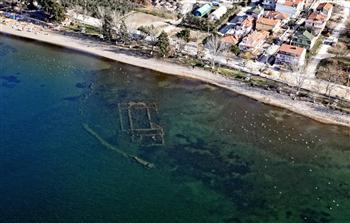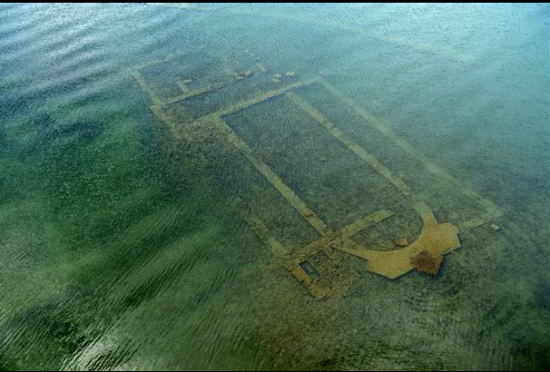AA Photos
Source - http://www.hurriyetdailynews.com/academics-work-on-mystery-of-lost-church-at-the-bottom-of-lake-iznik.aspx?pageID=238&nID=61782&NewsCatID=375
Archaeologists, historians and art historians are working on a church discovered off the shore of Bursa’s Lake İznik. They have found out that the structure was built under the name of St. Neophytos, a beloved Christian in the middle ages

Experts say they have obtained significant information about the church. They estimate that it collapsed during an earthquake that occurred in 740. DHA Photo
The mystery of an ancient basilica (big church), the remains of which have been discovered about 20 meters from the shore in Bursa’s Lake İznik, have begun to be unveiled. The foundations of the 600-year-old church are currently lying in water that is about 1.5 to two meters deep.

Archaeologists, historians and art historians are working on the church, which is estimated to have collapsed during an earthquake that occurred in the region in 740. They found out that this monumental structure was built in honor of St. Neophytos, who was killed aged 16 by Roman soldiers in 303 before the Edict of Milan, a proclamation that permanently established religious toleration for Christianity within the Roman Empire.
Uludağ University Head of Archaeology Department Professor Mustafa Şahin said that the basilica had been discovered while photographing the city from the air to make an inventory of the historical and cultural artifacts, and they had held repeated meetings with experts on the Eastern Rome, and examined lots of resources.
He said that they had obtained significant information about the church during works with Associate Professor of the same university, Şahin Kılıç and Ege University Art History Department member Associate Professor Emine Tok. “Since the beginning, the church was built in the 4th – 5th century because it has similarity to the plan of İznik’s Hagia Sophia Church.”
Şahin said that they had encountered the name “St. Neophyts,” adding, “Neophytos is among the saints and devout Christians, who were martyred during the time of Roman emperors Dioclasien and Galerius, when bans and punishments against Christians were common. According to resources, he was a saint who was killed by Roman soldiers in 303, 10 years before the Edict of Milan that freed Christianity.”

He was a beloved saint
Şahin said that the church was established with his name in the place where he was killed. He said that the date of the church construction was not precisely determined but it could have been built after 313.
“There is one more date, which important for us. Most probably, it could have been built in 325 after the first council meeting in İznik. In any case, we think that the church was built in the 4th century or a further date. It is interesting that we have gravures from the middle ages depicting this killing. We see Neophytos being killed on the lake coast,” he said, adding that he was a beloved saint.
According to ancient resources, Christians definitely stopped by İznik in the middle ages while making their pilgrimage, and visited the church. “Rumor has it that people in İznik were asking for help from the body of Neophytos when they were in difficulty,” he said.
Şahin said that Neophytos had been loved by the Christian Orthodox community and the Orthodox Church had been organizing feasts every year on Jan. 21, which is a significant date for İznik and Christianity. “The church was rediscovered on the same date, Jan. 21, 1250 years after it was submerged under water. This is an interesting thing,” he said.